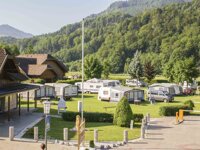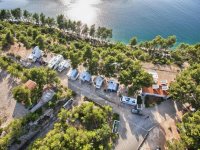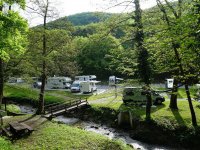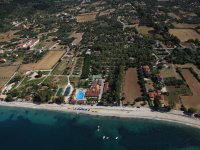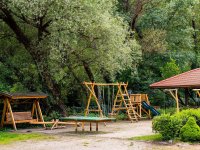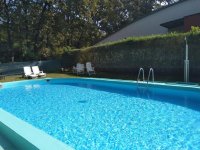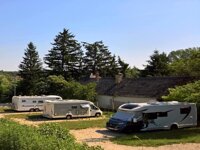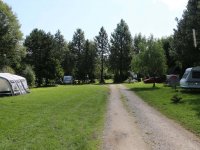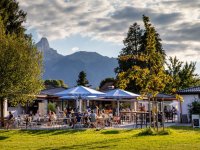
Dark Sky Reserve Camping in Central and Eastern Europe
Discover hidden gems in Austria, Croatia, Greece, Hungary, Poland and Switzerland: Dark Sky Camping.
Dark sky camping enthusiasts in Austria can find ideal spots in the Hohe Tauern National Park, where minimal light pollution allows for stunning views of the stars. In Croatia, the Velebit Dark Sky Park offers excellent opportunities for camping under pristine night skies, surrounded by the beauty of nature. Greece's Vikos-Aoos National Park provides a magical setting for dark sky camping, with its remote location and minimal light pollution ensuring an unforgettable stargazing experience.
In Hungary, the Bükk National Park offers designated camping areas where visitors can enjoy clear views of the night sky. Poland's Bieszczady Dark Sky Park is another fantastic destination for camping enthusiasts, offering expansive vistas of the star-filled heavens. Finally, Switzerland's Val Müstair Biosphere Reserve provides secluded camping spots amidst stunning alpine scenery, perfect for immersing oneself in the wonders of the night sky. Each of these destinations promises unforgettable experiences for those seeking to camp under some of Europe's darkest and most pristine skies.
Austria
Attersee-Traunsee IDS Park
Naturpark Attersee-Traunsee
Location Upper Austria, Austria
Status International Dark Sky Park
Year of Designation 2021
Area 106km2
The Attersee-Traunsee Nature Park, the largest in Upper Austria, covers 77 square kilometres and encompasses the Traun and Atterseer Flysch Mountains between Lakes Attersee and Traunsee.
This diverse landscape offers stunning views, from fruit trees in bloom to colourful forests. Nestled in the Alps' foothills, the park boasts some of central Europe's darkest night skies, offering panoramic vistas from its unforested hilltops.
Naturpark Attersee-Traunsee International Dark Sky Park Campsites
Croatia
Jelsa IDS Community
Jelsa
Location Hvar, Croatia
Status International Dark Sky Community
Year of Designation 2022
Area 121km2
The Municipality of Jelsa, located on the island of Hvar, Croatia, encompasses 12 settlements and is home to 3,582 inhabitants. Recognised as Croatia's first International Dark Sky Community and third International Dark Sky Place, Jelsa boasts a rich history dating back to Roman times.
To preserve its pristine night sky, over 1,000 public lights have been retrofitted with environmentally friendly fixtures, and community engagement initiatives include public events and school activities aimed at raising awareness about the importance of dark sky preservation.
Jelsa International Dark Sky Community Campsites
Petrova Gora-Biljeg IDS Park
Petrova Gora-Biljeg
Location Kordun, Croatia
Status International Dark Sky Park
Year of Designation 2019
Area 29km2
Petrova Gora is renowned for its stunning and well-preserved mountain forest landscapes in Croatia. Designated as a protected area in 1969 under the category of "significant landscape," Petrova Gora-Biljeg is safeguarded to maintain its forest habitat, stream valleys, and cultural and historical values for sustainable development, tourism, and recreation.
Petrova Gora-Biljeg International Dark Sky Park Campsites
Vrani Kamen IDS Park
Vrani Kamen
Location Gornji Borki, Croatia
Status International Dark Sky Park
Year of Designation 2019
Area 80km2
The name "Vrani Kamen" originates from the Proto-Slavic word "vorn," which evolved into "vran" in modern usage, meaning "raven" in English. Located in the Republic of Croatia, Vrani Kamen Park is predominantly managed by Croatian Forests, with the Petrov Vrh area overseen by the town of Daruvar.
Nestled near Daruvar, the park spans 8,000 hectares of the Papuk mountain in Western Slavonia and is conveniently situated 130 km from Zagreb, 140 km from Osijek, 300 km from the Adriatic coast, 65 km from Hungary, and 60 km from Bosnia and Herzegovina.
Petrova Gora-Biljeg International Dark Sky Park Campsites
Greece
Aenos IDS Park
Aenos National Park
Location Kefalonia, Greece
Status International Dark Sky Park
Year of Designation 2023
Area 28km2
Named after the highest peak on the Ionian Island of Kefalonia, Greece, Aenos National Park is the country's smallest national park. Established in 1962 to protect the Abies Kefalonica fir forest, it is rich in flora and fauna and part of the Kefalonia-Ithaca UNESCO Global Geopark.
Despite low levels of light pollution from nearby islands, the park boasts exceptional darkness, especially in its interior. Efforts to mitigate light pollution include retrofitting lighting at transmission sites and beaches frequented by egg-laying turtles, and educational resources emphasise responsible outdoor lighting.
Aenos National Park International Dark Sky Park Campsites
Hungary
Bükk IDS Park
Bükk National Park
Location Northern Hungary, Hungary
Status International Dark Sky Park
Year of Designation 2017
Area 431km2
Bükk National Park, Hungary's largest, spans 43,170 hectares in the Bükk Mountains near Miskolc. Renowned for its limestone landscape and diverse bird species, it's a haven for outdoor enthusiasts.
In recent years, the park has expanded its offerings to include stargazing and nocturnal environment events. These activities attract visitors from across Europe, catering to both casual stargazers and amateur astronomers.
Bükk National Park International Dark Sky Park Campsites
Hortobágy IDS Park
Hortobágy National Park
Location Eastern Hungary, Hungary
Status International Dark Sky Park
Year of Designation 2011
Area 820km2
Hortobágy, Hungary's premier national park, boasts Europe's largest continuous native grassland and holds UNESCO World Heritage, Biosphere Reserve, and Ramsar Convention status. Preserved since the last ice age, its ancient marshes and alkaline flats provide a sanctuary for diverse wildlife, especially birds.
While prioritising avian protection in its lighting management plan, the park also caters to astronomical interests, offering nighttime walks, educational programs on light pollution, and plans to establish an observatory within its 10,000-hectare designated area, known as Hortobágy Starry Sky Park.
Hortobágy National Park International Dark Sky Park Campsites
Zselici IDS Park
Zselic National Landscape Protection Area
Location Southern Hungary, Hungary
Status International Dark Sky Park
Year of Designation 2009
Area 105km2
The Zselic Starry Sky Park, part of the Zselic National Landscape Protection Area, began in 1976 as a collaboration between the Duna-Dráva National Park Directorate and the Hungarian Astronomical Association. Covering 9,042 hectares, it involves 17 nearby municipalities and the Lighting Society of Hungary to minimize light pollution.
Zselic National Landscape Protection Area International Dark Sky Park Campsites
Poland
Sopotnia Wielka IDS Community
Sopotnia Wielka
Location Silesian Voivodeship, Poland
Status International Dark Sky Community
Year of Designation 2023
Area 105km2
Sopotnia Wielka, nestled in the Żywiec Beskids, is a picturesque village celebrated as an International Dark Sky Community. Its rich history dates back to Wallachian settlers and its role in logging and agriculture. In the late 1990s, residents championed reduced street lighting to combat light pollution.
Today, all street lamps are shielded, making it a prime destination for astro-tourism. Regular workshops and events educate residents and tourists, while a Rational Lighting Policy ensures continued commitment to preserving the dark sky environment.
Sopotnia Wielka International Dark Sky Community Campsites
Switzerland
Gantrisch IDS Park
Gantrisch Dark Sky Zone
Location Bern/Friebourg, Switzerland
Status International Dark Sky Park
Year of Designation 2024
Area 104km2
The Gantrisch Dark Sky Zone, nestled in the Bernese Prealps, spans 10,000 hectares and is part of the larger Gantrisch Regional Nature Park. Recognised for its natural beauty and ecological significance, this zone comprises 19 communities across two cantons. Efforts to preserve natural darkness led to Dark Sky Park certification, supported by initiatives like the "Light Toolbox" and regional lighting guidelines. These guidelines promote responsible lighting practices, categorising the park into E0 and E1 zones.
Collaboration with DarkSky International and stakeholder support paved the way for certification, marking a significant milestone in combating light pollution. Public awareness events, including a regional star party held for over 30 years, engage both astronomy enthusiasts and the general public in appreciating and protecting the night sky.